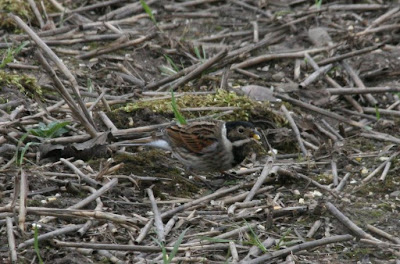
View across Frodsham salt marsh from the top of No. 6 tank - Liverpool Airport can be seen on the opposite side of the Mersey.
Cormorants hanging out in a dead tree in No. 6 tank
xxx
The day started off with a quick trip to HGF. 2 Grey Partirdges were showing well in the field opposite the kennels. New were a pair of Goldeneye (rare this winter) - I tried to digiscope the drake, however an annoying 1st winter BHG kept mobbing them. The pair of Teal that turned up on Thursday are still present. 83 Wigeon were in residence (48 drakes) with 9 Tufties and 2 Pochard. The Great Crested Grebe pair that also turned up on Thursday were again engaged in courtship display with the third bird doing a good impression of a Billy No Mates. Other than that it was like a singles bar with 1 Redshank, 1 Lapwing, 1 Meadow Pipit, 1 Skylark, 1 Kestrel, 1 Pied Wagtail!!!
xxx
At the feeding station the dynamic has changed again. For the last 2 weeks it has been all Tree Sparrows with few Chaffinches - today it was the opposite. All the birds are feeding and then hopping back into cover around the treatment works, consequently there is a much larger throughput than is immediately obvious. Today 2 Bramblings (1 male, 1 female) were joined by at least 45 Chaffinches. Also around were 11 Reed Buntings (7 males, 4 females), 9 Tree Sparrows, 5 Yellowhammers, 2 Grey Partridges, 3 Song Thrushes and 3 Greenfinches. On Friday evening 9 Grey Partridges were present (4 pairs) and a great deal of scuffling broke out again.
xxx
In the garden the bird of the day was a cracking male Siskin on the feeders at lunch. It was associating with 7 Goldfinches. Approx 12 Chaffinches and 2 Reed Buntings were also coming in. Curiously Starlings are uncommon visitors to the garden in numbers. I usually see only significant numbers in autumn when the juveniles flatten the fat balls - the rest of the year I am lucky to see an odd bird. Consequently it was very nice to see a flock of 54 stick around in the garden this morning. Also present were 2 Crows, 24 Collared Doves, 2 Grey Partridges and a Coal Tit. A Sparrowhawk killed another Collared Dove in the garden on Thursday.
xxx
While chauffering Karen to the hair dressers in Newton I popped round to Newton Lake this morning. A pair of Nuthatches were present around the church car park with a third bird calling nr the lake. Also present were 2 Mute Swans, 3 Canada Geese (possible the same three that visited HGF on Thursday?), 24 Teal, and 11 Tufties. 4 Jays were in Lady Lane late morning. Yesterday a Corn Bunting was present on the wires outside Holcroft Hall farm in Culcheth.
xxx
Following a trip to the pet shop mid afternoon and diverting out of Warrington via Stockton Heath in order to avoid the chaos, I then decided to have a quick walk around Frodsham Marsh. The first bird I saw was a female Merlin perched on a fencepost on No. 5 tank. She posed nicely though she was very distant and a couple on a nature walk were thrilled to get their first ever views of a Merlin through my scope. Also present on No. 6 tank were:
Following a trip to the pet shop mid afternoon and diverting out of Warrington via Stockton Heath in order to avoid the chaos, I then decided to have a quick walk around Frodsham Marsh. The first bird I saw was a female Merlin perched on a fencepost on No. 5 tank. She posed nicely though she was very distant and a couple on a nature walk were thrilled to get their first ever views of a Merlin through my scope. Also present on No. 6 tank were:
xxx
470+ Golden Plover
52 Ringed Plover
27 Dunlin
5 Ruff
82 Curlew
250+ Lapwing
1 Black-tailed Godwit
450+ Teal
45 Ruddy Duck
42 Wigeon
2 Pintail
2 Shelduck
4 Shoveler
26 Cormorant
22 Grey Heron
1 Little Egret
9 Pied Wagtails
80+ Common Gulls
1 Great Black-backed Gull (2nd winter)
xxx
On the salt marsh 2 Greylags were feeding with 53 Canada Geese, however any hopes of a SEO sighting were dashed when I spotted several tents on the marsh. I can't believe people are allowed to camp there!





















































